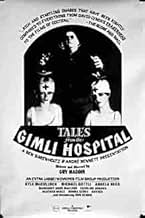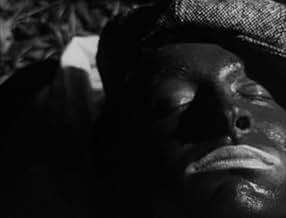Tales from the Gimli Hospital
- 1988
- 1h 12min
VALUTAZIONE IMDb
6,6/10
1576
LA TUA VALUTAZIONE
Aggiungi una trama nella tua linguaWhile their mother is dying in the modern Gimli, Manitoba hospital, two young children are told a tale by their Icelandic grandmother about Einar the Lonely, his friend Gunnar, and the angel... Leggi tuttoWhile their mother is dying in the modern Gimli, Manitoba hospital, two young children are told a tale by their Icelandic grandmother about Einar the Lonely, his friend Gunnar, and the angelic Snjofridur in a Gimli of old.While their mother is dying in the modern Gimli, Manitoba hospital, two young children are told a tale by their Icelandic grandmother about Einar the Lonely, his friend Gunnar, and the angelic Snjofridur in a Gimli of old.
- Regia
- Sceneggiatura
- Star
- Premi
- 1 candidatura in totale
Ron Eyolfson
- Pastor Osbaldison
- (as Ronald Eyolfson)
- …
Recensioni in evidenza
The comments made above by "Spearin" express my own reaction to this film.
I rented it on DVD because it sounded intriguing, but fully expected to yank the disc before it fairly got underway. To my pleased surprise, I was caught up in the story and captivated by the photography from the first seconds, and thoroughly enjoyed the experience--so much so, in fact, that I immediately replayed the movie with the director's often droll narration superimposed.
Also on the DVD I rented was a short film by the same author, "The Dead Father," which is well worth watching. It, perhaps even more than "Tales from the Gimli Hospital," evokes early French surrealist film, but not in a slavish way.
Both films gave me food for thought--about film and about human relationships. I guess this "nourishment" aspect of film-viewing is my basic criterion for judgment. On that basis, I voted an "eight" for "Tales from the Gimli Hospital."
By the way, I was very interested to learn (from the director's commentary) some of the actual history of Gimli and its settlers. These were tough, courageous people.
I rented it on DVD because it sounded intriguing, but fully expected to yank the disc before it fairly got underway. To my pleased surprise, I was caught up in the story and captivated by the photography from the first seconds, and thoroughly enjoyed the experience--so much so, in fact, that I immediately replayed the movie with the director's often droll narration superimposed.
Also on the DVD I rented was a short film by the same author, "The Dead Father," which is well worth watching. It, perhaps even more than "Tales from the Gimli Hospital," evokes early French surrealist film, but not in a slavish way.
Both films gave me food for thought--about film and about human relationships. I guess this "nourishment" aspect of film-viewing is my basic criterion for judgment. On that basis, I voted an "eight" for "Tales from the Gimli Hospital."
By the way, I was very interested to learn (from the director's commentary) some of the actual history of Gimli and its settlers. These were tough, courageous people.
Fans of David Lynch and early Luis Buñuel will find plenty to admire (or scratch their head at) in this esoteric, shoestring budget mock Icelandic folk tale, set in a bleak sub-arctic village where victims of a mysterious plague are treated by having their sores caressed with dead seagulls. Winnipeg director Guy Maddin borrows extensively from the primitive vocabulary of the early sound era (with grainy photography, a scratchy music score, and crude post-dubbed dialogue) to create a nonsensical 70-minute punchline with no joke attached. The antique style of the production would have to be considered its own reward, especially since the story itself (involving incest, hints of necrophilia, and a mysterious butt-grabbing duel to the death) leads nowhere in particular. The awkward emoting by Nordic characters named Gunnar, Snjofridur, and Einar the lonely; the Louise Brooks look-alike nurses; and the cameo appearance of a black-faced vaudeville minstrel are all reminiscent of some nightmarish, early 1930s melodrama, but Maddin's aesthetic is aimed squarely at today's midnight cult audiences.
Guy Maddin's "Tales from Gimli Hospital" is a surreal locomotive of a film that never for a second pretends to make a lick of sense. Characters and events lack logic and motivation, leaving the proceedings within an oddball world of duck feathers, Indian burials, and mute men (some in blackface). The result is intriguing yet pretentious and too deliberately ambiguous (while "Eraserhead" made less narrative sense, its 'clues' were more meticulously assembled), but shows promise from writer-director Guy Maddin, who successfully invokes the classic styles of German Expressionism and even "Hour of the Wolf"-era Ingmar Bergman.
If you are looking for something unorthodox and bizarre and very arty, you should look into this. Guy Maddin turned his obsession with silent movies, surrealism, Luis Bunuel, David Lynch and god known what else into...something. I probably don't possess enough movie knowledge to competently judge this one or grasp everything that's going on, but I suppose that Maddin has something going here. Not that I had a lot of fun watching it. This is for an exquisite taste only. Nonetheless, it still left me curious about Maddin's other works.
Here's a movie that took its miniscule budget and really made the most of it.
How? Well, take a look at the looping synchronization. It can't be done well without being expensive, so they do very little of it, and get around the problem by shooting characters from obtuse angles that hide the problem. Color's expensive too, so it's in black and white. And music? You can hear the needle drop on the record.
But the money they spent went in the right areas. The visuals are so strong and the camera placement sometimes so unexpected that you find yourself wondering what it is you're looking at--and then something moves, and the tableau breaks apart into a conventional scene. The opening sequence, a long sfx pan down to the Gimli hospital, going through clouds and angels, evokes the 1940s so well that you halfway expect to see William Bendix in one of the beds. The costuming is strange and the plot seems totally unworkable, and yet it pulls you in and keeps you there, never seems to make a horrible misstep, and at times hits exactly what it's aiming for.
Sure it's an amateur film. But look at the nice smooth camera work, the well-paced editing, the good choices in music for mood. While it's all too easy to cite Cocteau, Blood of a Poet comes to mind often while watching Tales from the Gimli Hospital, thanks to the surprising interruption of the narrative by little bits of surreal magic. You don't walk away from this one saying that it could have been done better--instead, you wonder how it was done so well for so little.
How? Well, take a look at the looping synchronization. It can't be done well without being expensive, so they do very little of it, and get around the problem by shooting characters from obtuse angles that hide the problem. Color's expensive too, so it's in black and white. And music? You can hear the needle drop on the record.
But the money they spent went in the right areas. The visuals are so strong and the camera placement sometimes so unexpected that you find yourself wondering what it is you're looking at--and then something moves, and the tableau breaks apart into a conventional scene. The opening sequence, a long sfx pan down to the Gimli hospital, going through clouds and angels, evokes the 1940s so well that you halfway expect to see William Bendix in one of the beds. The costuming is strange and the plot seems totally unworkable, and yet it pulls you in and keeps you there, never seems to make a horrible misstep, and at times hits exactly what it's aiming for.
Sure it's an amateur film. But look at the nice smooth camera work, the well-paced editing, the good choices in music for mood. While it's all too easy to cite Cocteau, Blood of a Poet comes to mind often while watching Tales from the Gimli Hospital, thanks to the surprising interruption of the narrative by little bits of surreal magic. You don't walk away from this one saying that it could have been done better--instead, you wonder how it was done so well for so little.
Lo sapevi?
- QuizAccording to Guy Maddin the plot of Tales from the Gimli Hospital (1988) was inspired by "The Eternal Husband," by Fyodor Dostoevsky, and Maddin's own experience of cuckolding a friend.
- ConnessioniFeatured in Guy Maddin: Waiting for Twilight (1997)
I più visti
Accedi per valutare e creare un elenco di titoli salvati per ottenere consigli personalizzati
- How long is Tales from the Gimli Hospital?Powered by Alexa
Dettagli
- Data di uscita
- Paese di origine
- Lingue
- Celebre anche come
- Geschichten aus dem Gimli Hospital
- Luoghi delle riprese
- Aziende produttrici
- Vedi altri crediti dell’azienda su IMDbPro
Botteghino
- Budget
- 25.000 USD (previsto)
- Tempo di esecuzione
- 1h 12min(72 min)
- Colore
- Mix di suoni
- Proporzioni
- 1.37 : 1
Contribuisci a questa pagina
Suggerisci una modifica o aggiungi i contenuti mancanti






















